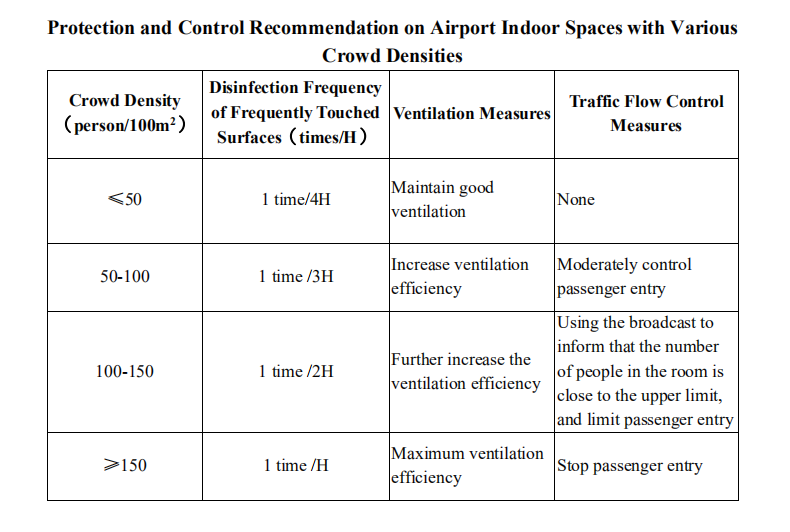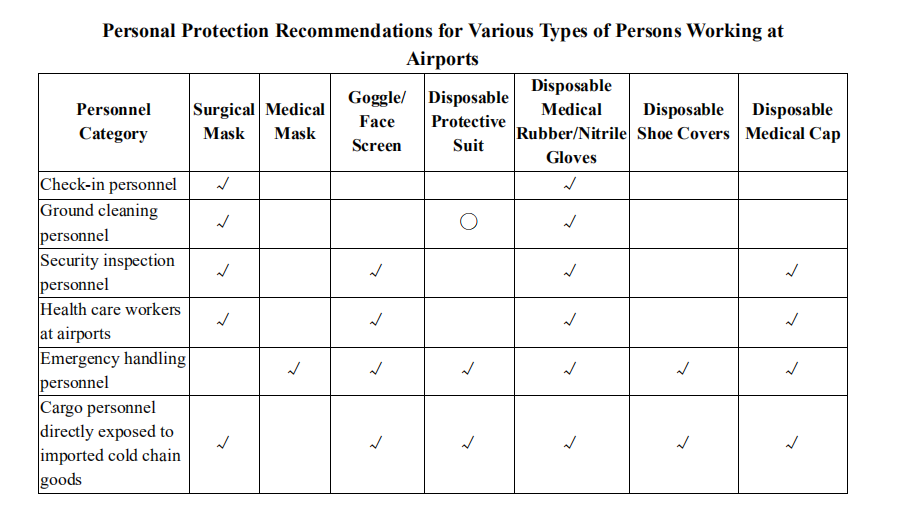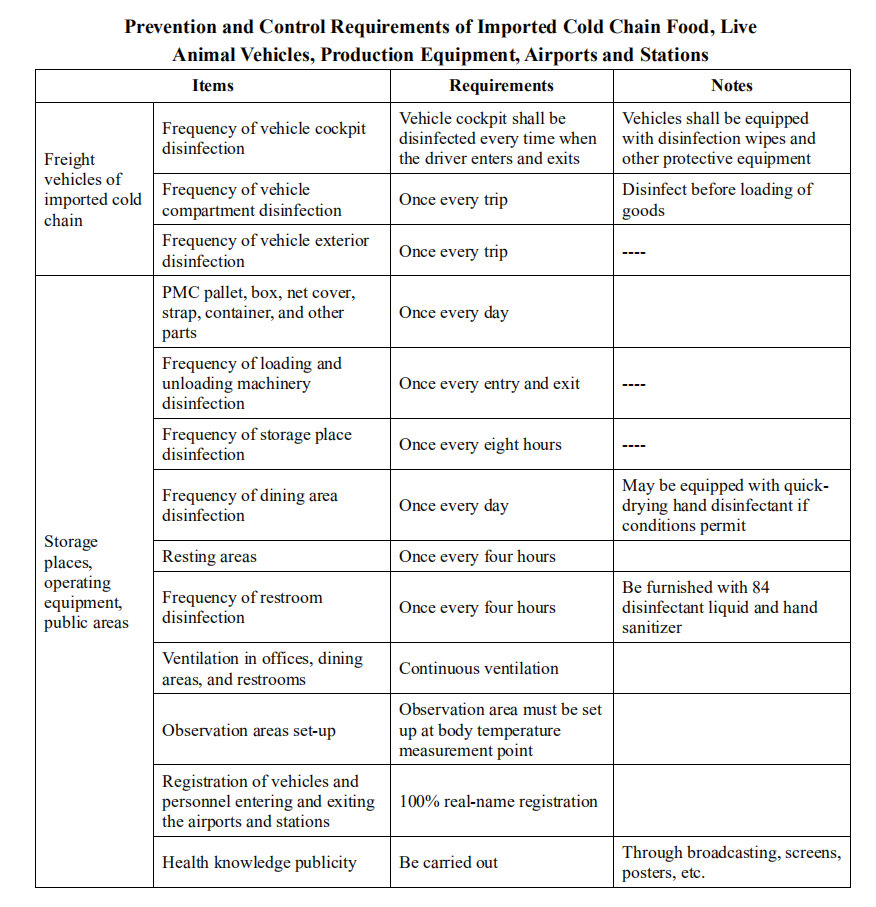Sixth Edition-Preventing Spread of Coronavirus Disease 2019 (COVID-19) Guideline for Airports
Preventing the Spread of Coronavirus Disease 2019 (COVID-19)
Guideline for Airports
Sixth Edition
In order to do a good job in normalized disease prevention and control, strictly implement various measures that guard against “disease importation and domestic resurgence”, intensify measures against “virus spread via humans and cargo”, and improving prevention and control measures taken by airports, the sixth edition of Preventing the Spread of Coronavirus Disease 2019 (COVID-19) Guideline for Airports is developed.
1. Prevention and Control Measure for Passengers during Air Travel
1.1 In a bid to reduce personnel contact, it is encouraged to use self-service check-in through mobile phone applications, and to scan the QR code when boarding.
1.2 Passenger management should be strengthened by requiring passengers wearing masks when they enter the terminal. Corresponding passenger traffic flow control and diversion measures as well as early alerting mechanisms should be adopted to promptly disseminate dynamic information to passengers/personnel, and to inform and guide them to maintain a social distance over one meter to prevent massive concentration. When the density of passengers in the waiting hall is too high, they should be diverted in a timely manner. Please refer to Attachment 1 for specific traffic flow control measures with different crowd densities. The number of people in elevators should be limited to avoid crowding in confined spaces.
1.3 The process of baggage-claim should be optimized to enhance its speed and avoid long-time waiting. Posts and floor markings should be set up in the waiting area of baggage-claim to keep passengers standing with over one meter between each other and avoid crowding.
1.4 Calibrated non-contact thermometers should be equipped at proper places of terminals, and all arriving and departing passengers should have their body temperatures measured. Quarantine areas for feverish passengers should be set up. Once feverish passengers are found, they should be required to record personal information and their means of contact immediately. Medical departments of airports should be notified in a prompt manner for quarantine. Local health departments should also be informed, and supports should be provided for the take-over of the passengers concerned.
1.5 If there are existing local COVID-19 cases in the points of origin, the airport thereof shall require departing passengers to present their health QR codes, and negative results of nucleic acid tests if necessary. The validity for test results varies in accordance with the regulations of the relevant local departments.
1.6 Passengers should be provided with necessary hand sanitizers and disinfection products at proper places of terminals, and those products should be replaced promptly.
1.7 Flights carrying passengers with suspicious symptoms should be parked in remote stands, and special passages for passengers should be set up.
2. The Setting-up and Management of Quarantine Areas for Feverish Passengers
2.1 Quarantine areas shall be set up in a place that is well-ventilated with low passenger density, relatively independent, and convenient for closed-off management. A fully enclosed tent could be used based on the actual situation for re-checking body temperature.
2.2 Warning lines or obvious signs should be set up around the quarantine areas.
2.3 Necessary disease prevention and control materials should be stored in the quarantine areas, such as medical protective clothing, medical N95 masks, goggles, disposable sterile gloves, air sterilizers, medical waste bags, etc.
2.4 The quarantine areas and the paths that feverish passengers walk along shall be disinfected when those passengers leave the areas.
3. Prevention and Control Measures for Security Inspection Personnel, Health Care Workers, Ground Cleaning Staff and Personnel Working at Check-in Counters
Prevention and control standards vary for different types of personnel, and please refer to Attachment 2 for details. Attention should be paid to the following points:
3.1 The mask should be close to the face, covering the nose and mouth completely. When the mask is on or being removed, hands must not touch the out layer of the mask to avoid hands contamination. Once dampened by secretions or contaminated by other contaminants, facial masks must be replaced immediately with new ones, and hands should be cleaned with sanitizer both before and after the replacement.
3.2 All disposable protective equipment, after their use, should be placed in yellow medical waste bags. They should be sprayed or sprinkled till fully soaked with chlorine-based disinfectant (500mg/L-1000mg/L) before cleaning, and then the yellow medical waste bags should be tightly knotted for centralized disposal as medical wastes.
3.3 Alcohol-based disinfection wipes or instant hand sanitizer should be used for hand cleaning and disinfection. Hands shall be kept away from nose, mouth and eyes when it is not sure whether they are clean or not. When sneezing or coughing, one should try to lower the head or turn away from people nearby, and cover the mouth and nose with tissue or flexed elbow. After touching or disposing contaminated articles, hands should be cleaned with soap or hand sanitizer under running water followed by hand disinfection.
3.4 Reusable goggles should be sterilized and dried after each use. Goggles with an anti-fogging film should avoid being wiped with disinfectant. Instead, it is recommended that they be washed with clean water, and then exposed to close-range direct ultraviolet lighting for over 30 minutes in rooms with no person inside.
3.5 For personnel working at document verification and body searching posts, their work uniforms should be subject to centralized high-temperature steam disinfection for 20 to 40 minutes or soaked in 500mg/L chlorine-based disinfectant for 30 minutes before regular washing when they are off duty for the day. 75% alcohol can be applied to wipe or spray clothes in case of emergency.
3.6 The protection standards for ground handling personnel who are exposed to international flight crews and international inbound cargo and baggage shall be implemented in accordance with the requirements in the Preventing the Spread of Coronavirus Disease 2019 (COVID-19) Guideline for Airlines.
4. Airport Ventilation
The management of air-conditioning systems and natural ventilation in public places such as terminals should be enhanced. Practical measures can be taken according to the structure and layout of terminals as well as local climate to improve air circulation. If the temperature is agreeable, doors and windows can be opened; where air-conditioning systems are used, full fresh air operation mode can be started as appropriate, and exhaust system should be turned on to keep the air clean. When the indoor temperature cannot meet the requirements, the air supply volume can be reduced. When the flow of people is large, the fresh air and exhaust system of the air conditioning system should continue to operate for a period of time after the end of the flight every day.
When the density of passengers in the waiting hall is too high, the ventilation efficiency should be increased. In addition, the ventilation efficiency shall be adjusted according to the indoor crowd density at airports. Please refer to Attachment 1 for details.
5. Hygiene Requirements for Ferry Buses
For disinfection methods and selection of disinfectant for ferry buses, please refer to the Technical Guidance for the Disinfection Operation of Public Transport Vehicles.
If conditions permit, ferry buses can operate at a low speed with windows open to maintain natural ventilation. By increasing the frequency of ferry buses, it can be ensured to the greatest extent possible that passengers could stand with at least one meter between each other and avoid crowding. Preventative disinfection needs to be performed after the daily operation, during which frequently touched surfaces such as hanging straps, handrails and seats should be the focuses and be wiped or sprayed with disinfectant. Tires do not need to be disinfected. If a ferry bus has carried passengers with suspicious symptoms, it should be subject to terminal disinfection by professionals.
6. Hygiene Requirements for Security Inspection Areas
The management of air-conditioning systems and natural ventilation in security inspection areas should be enhanced to keep the air clean, and civil aviation security inspection aisles should be equipped with relevant facilities to enhance ventilation. Cleaning and disinfection should be conducted on a regularly basis every day, and the frequency of disinfection should be adjusted according to the flow of people. After the daily operation, areas and facilities such as security inspection sites and waste bins should be wet-cleaned, and all-round disinfection needs to be performed to keep the environment clean. Key areas (document verification counters, baggage packing areas, baggage plates, hand-held metal detectors) and security screening facilities should be disinfected, and hand sanitizers should be provided in screening aisles.
7. Wastes Disposal
The management of wastes sorting and the collection of used masks should be enhanced so that wastes could be cleaned in time. The cleaning of wastes containers such as trash cans should be intensified, and disinfection of trash cans should be performed after garbage collection, either by spraying or wiping with 500mg/L chlorine-based disinfectant. When potentially contaminated wastes are found, the wastes should be disposed of as medical wastes in a centralized way.
8. Disinfection of Airport Public Areas
Disinfection of airport public areas should refer to the Guidelines for Prevention of Novel Coronavirus Infection in Public Places, Guidance of Disinfection Techniques in Public Places, and Guidance for the Use of Disinfectants.
It is recommended that airports shall carry out preventative cleaning and disinfection as needed, and disinfection of key crowded areas shall be carried out at least twice a day. In addition, when personnel flow at indoor places of the airport is large, the disinfection frequency of frequently-touch objects should be increased. Please refer to Attachment 1 for details.
8.1 Daily Preventative Cleaning and Disinfection
Preventative cleaning and disinfection of airport public areas should be conducted.
8.1.1 Air disinfection: use natural ventilation where climatic conditions allow, and chemical disinfection is not recommended. Air conditioning ventilation system should be cleaned and disinfected on a regular basis. 250mg/L to 500mg/L chlorine-based disinfectant or 250mg/L chlorine dioxide spray could be sprayed or wiped for reaction of 10 to 30 minutes.
8.1.2 Surface disinfection: crowded places and frequently-touch surfaces (such as self-check-in or check-in counters, document verification counters, buttons in elevators, and handrails) should be the focuses. 250mg/L to 500mg/L chlorine-based disinfectant or 250mg/L chlorine dioxide spray could be used together when wiping, and water shall be applied for cleaning after 30 minutes of reaction.
8.1.3 In a bid to prevent secondary hazards, it is not recommended to disinfect areas such as the ground and security inspection queuing barriers etc. unless there are suspicious pollutants. Instead of disinfectant, ultraviolet rays can be used in some places for environment and surface sterilization when conditions allow.
8.2 Terminal Disinfection
When suspected or confirmed cases or passengers with suspicious symptoms are found in airports, terminal disinfection should be performed by professionals. The procedures of terminal disinfection shall follow the Appendix A of the General Principle on Disinfection for Infectious Focus (GB19193-2015). On-site disinfection personnel should ensure their personal protection when preparing and using chemical disinfectants. It is recommended to choose one of the following methods:
8.2.1 Hydrogen peroxide vapor (gas) sterilization devices can be used for integrated disinfection of the air, the environment and surface of objects. The specific operation can be performed according to the equipment instruction manual.
8.2.2 0.5% peroxyacetic acid, 3% hydrogen peroxide, or 500mg/L chlorine dioxide can be adopted for air disinfection, by way of aerosol spray, with 10-20ml/m³. Windows should be closed before disinfection, and the surface and the space shall be evenly sprayed, starting from up-down, and then from left to right. Windows can be opened for ventilation after 60 minutes of reaction. After spray disinfection, the surface of objects may be wiped (swept) in the way of daily disinfection.
8.2.3 For key passenger areas, 500mg/L to 1000mg/L chlorine-based disinfectant can be applied by spraying or wiping for reaction of more than 30 minutes. If there are contaminated body fluids such as vomit and blood, 10000mg/L chlorine-based disinfectant shall be applied for over 30 minutes before removing the contaminated body fluids, and then the area should be cleaned and disinfected.
9. Handling Procedures of Flights from Pandemic Countries or Flights with Passengers with Suspicious Symptoms
Dedicated parking apron shall be set up for such flights, or remote stands should be used. After landing, the following procedures should be followed:
9.1 Disembarking passengers are required to wear surgical masks or masks of higher standards. Accompanying airport staff should wear surgical masks or masks of higher standards, and disposable rubber gloves.
9.2 The airport should coordinate with local customs to set up a special waiting area, and provide passengers with basic daily necessities such as food. After passengers’ departure, preventative disinfection shall be performed in the quarantine waiting area.
9.3 A separate baggage carousel should be designated at baggage-claim area to avoid crowding with other flight passengers and reduce the chance of cross infection.
10. Operating Procedures of Imported Cold-chain Food and Trans-shipment of Live Animals
10.1 Operating personnel shall be fixed to avoid a mixed scheduling of cargo personnel who have been directly exposed to cold chain transport and who have not.
10.2 Ground personnel who are directly exposed to cold-chain food and live animals shall regularly take nucleic acid tests and monitor their health. The frequency of nucleic acid tests shall refer to the regulations of the local authorities. Please refer to Appendix 2 for the personal protection standards.
10.3 Special passage and equipment should be used for cargo trans-shipment during ground transportation to avoid cross trans-shipment of different types of goods from various places of origin.
10.4 Preventative disinfection of frequently touched surface and public areas such as vehicles, loading and unloading equipment shall be carried out based on different risks of exposure. For specific disinfection frequency please refer to Appendix 3.
10.5 The outer packaging, plastic film and other wastes generated during the operation process must be collectively disinfected and shall go through innoxious treatment.
11. Disembarking Procedures of International Flight Crew
11.1 Special passages for crew members shall be set up to avoid mixture with passengers.
11.2 Airports shall coordinate with local customs and immigration departments to set up express channels to conduct epidemiological investigations, nucleic acid tests and checking of crew members, and avoid mixture with passengers carried by the same aircraft.
11.3 Isolation belts shall be used in the transfer hall to separate the passages and waiting areas for passengers and for crew members so as to avoid contact.
12. Operating Procedures in the Designated International/Regional Entry Supporting Areas
12.1 Personnel working in the designated entry supporting areas should fix both their posts and commuting routes to avoid mixture with personnel working in the domestic areas.
12.2 Domestic wastes and medical wastes in the designated entry supporting areas shall be transported through dedicated roads after disinfection. If dedicated roads for transport are not available, the wastes should be transported on relatively fixed routes and should avoid peak hours.
12.3 Personnel working in the designated entry supporting areas should avoid using public facilities together with passengers and staff of other areas.
13. Considerations Regarding Psychological Self-regulation for Front-line Personnel of Airports
The domestic prevention and control of the COVID-19 have entered the normalized phase; however, front-line employees are still under pressure as they have to support flight operation and practice self-protection. Therefore, continued effort should be made in providing humanistic care and psychological counseling for employees, to calm down negative emotions in time.
14. Proper Use of Personal Protective Equipment
In order to provide guidance to front-line staff in civil aviation on how to correctly wear masks, hats, gloves, goggles and other protective equipment, and properly sanitize hands, our Office made a video, downloadable from the website ams.caac.gov.cn under Prevention and Control of Public Health Emergency.
Attachment 1

Attachment 2

Note:
1. Goggles and face screens are generally not used at the same time. Face screens shall be the first choice if there is a risk of being exposed to a large amount of splash.
2. ○ in the table is optional, it can be selected if necessary according to actual exposure risks and conditions, and √ means the choice is mandatory.
*The personal protection of cargo sorting personnel shall refer to Preventing the Spread of Coronavirus Disease 2019 (COVID-19) Guideline for Airlines for personnel protection.
Attachment 3

This is an un-official translation for reference.
Should there be any discrepancy in interpretation, the original Chinese version shall prevail.
更多动态
关于新冠疫情常态化防控期间规范国际定期客运航班计划管理的通知
为进一步规范国际定期航班预先飞行计划管理,切实维护消费者合法权益,落实《民用航空预先飞行计划管理办法》(CCAR-73)相关规定
- 民航局关于调整国际客运航班熔断措施的通知
- 关于进一步落实来华航班乘客实施远端防控措施有关工作的通知
- 关于切实做好来华航班乘客凭新冠病毒核酸检测阴性证明登机有关工作的通知
- 民航局、海关总署、外交部关于来华航班乘客凭新冠病毒核酸检测阴性证明登机的公告(附英文参考译文)
- Sixth Edition-Preventing Spread of Coronavirus Disease 2019 (COVID-19) Guideline for Airlines
- Sixth Edition-Preventing Spread of Coronavirus Disease 2019 (COVID-19) Guideline for Airports
- 关于目的地为北京的国际航班从指定第一入境点入境的公告(第3号)(附英文参考译文)
- 关于精准做好国际航空货运机组人员疫情防控工作的通知(附英文参考译文)
- 中国民用航空局 中华人民共和国海关总署关于中国籍旅客乘坐航班回国前填报防疫健康信息的公告(附英文参考译文)


